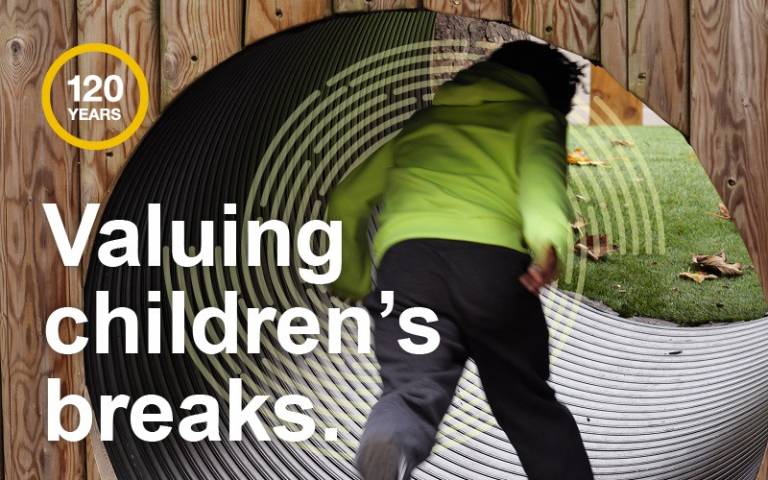School breaktimes offer a vital opportunity for children to interact with peers and develop social skills but break time has been reducing, limiting the opportunity for pupils to build these skills.

Despite being a recognised part of pupils’ school day, there is little national or international data on break times. IOE academics Dr Ed Baines and Professor Peter Blatchford have been leading research to look at the role of school breaks in children’s education and lives and how these have changed over time.
Their 2017 study, funded by the Nuffield Foundation, looked at how school breaks and young people’s social lives have changed over 25 years comparing data from over 1,000 primary and secondary schools in 2017 to data they collected in similar surveys in 2006 and 1995.
The researchers found that children at Key Stage 1 (five to seven years of age) had 45 minutes less break time per week than children of the same age in 1995 and pupils at Key Stage 3 and 4 (11 to 16 years) had 65 minutes less.
As well as overall shortening of breaktimes, the study revealed that a quarter of secondary schools have lunchtimes as short as 35 minutes or less. Some of the case studies revealed that this is barely enough time to queue up and to eat a meal, let alone meet or play with friends or participate in enrichment activities.
Why are breaktimes shrinking?
The main reasons school leaders give for the cuts to break time periods are to create more time for learning, to cover the curriculum, and so that schools can limit the poor behaviour that school staff say often occurs during breaks. These are much the same reasons given for the shortening of breaks reported in earlier surveys and are maybe not surprising in the light of the substantial pressure on schools year-on-year to ‘improve standards’. It is also likely that schools are beginning to reduce breaktimes further as part of a package of efforts to save time and money. This is reflected in concerns about school funding and worries about shortening the school week.” – Dr Ed Baines
Why is this important?
The reductions in break time ignore the inherent value of breaks for children, both in terms of children’s mental and physical wellbeing and development but importantly in terms of the opportunity breaks provide for developing positive social relationships and social skills. Breaktimes provide children with a level of independence to make their own decisions about the activities they engage in, the roles they adopt and the people they socialise with. This is within the safety of an adult supported context that can provide important lessons about everyday life, moral decisions, and relationships. Enjoyment of breaktimes may be important for children to feel positive about school.
Breaktimes also provide children with an opportunity to exercise, which is particularly important given obesity levels among UK teenagers. Reducing breaktimes could have a significant impact on children’s social development and physical health, particularly because for many children, breaks in the school day are some of the only times they get to socialise with peers for sustained periods of time. The study also found that outside school, children are half as likely to meet up with friends in person compared to previous decades, with 31% of children reporting that they seldom get to meet peers and friends in 2017 compared to 15% in 2006.
Professor Blatchford notes: “This is a startling finding and serves to highlight the central importance of school, and break times in particular, in the social lives of children and young people.”
In the study, school staff tended to emphasise breaks’ functional value as an opportunity to get some physical exercise, fresh air and something to eat rather than making an important and inherent contribution to children’s social and emotional wellbeing. In contrast to adults, pupils were overwhelmingly positive about taking breaks (particularly longer lunch breaks), with 87% of children saying they ‘liked’ or ‘really like’ them. Just 5% of children said they did not like break times. Both at primary and secondary levels pupils valued breaks largely for the opportunity they provide to socialise with friends. They also valued the opportunity for some free time, and the chance to choose what they wanted to do and/or to engage in playful activities.
The 2017 survey also found that there was an increase in the levels of supervision of children on the playground. This may reflect increased concerns about, and restrictions of, what children do during these times. The study also reported a tendency for primary and secondary schools to withhold breaks from pupils as a consequence for poor behaviour and not completing work. The authors suggest that schools need to think carefully about this practice, highlighting the importance of breaks for children's development. Witholding breaks may be counterproductive, and may serve to harm children that already suffer social and emotional difficulties and be reluctant to attend school.
In our report we recommend that schools should carefully consider the time available for breaks and refrain from cutting them further. Schools could productively work with pupils to improve school breaks in terms of the activities, resources and opportunities available. Given that breaktimes offer huge opportunities for children’s development particularly in the social realm, but also in terms of physical activity, play and wellbeing it is the right time for policy makers to consider legislating for break times in the school day for children and young people.” – Professor Peter Blatchford
 Close
Close


